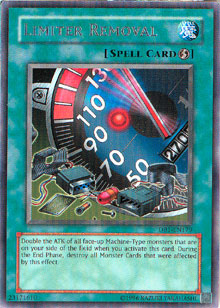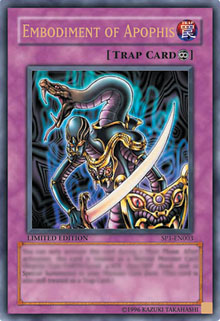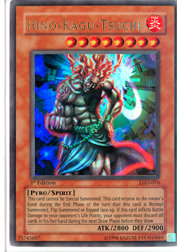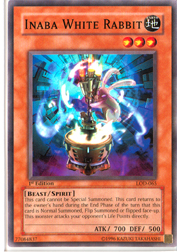An excellent way to tell how good a card or effect is in any TCG is by taking a look at any costs or downsides that may be associated with the card’s effect. In theory, the greater the cost or drawback, the more powerful the card is. Obviously, some cards don’t conform to this model (Pot of Greed, I’m looking at you), but for the most part, this is a good way to evaluate a card’s potential. Allow me to demonstrate.
 Limiter Removal: This card is capable of dealing a crippling blow to an opponent’s life points, or can even end the game in one turn. Its quick-play status also allows it to be sprung from the hand on offense or used from the field as a powerful defensive maneuver. The drawbacks? Well, for one, if you fail to win the game on the turn you play it, the chances are good that you’ll have an empty field for your opponent to attack during the next turn. Limiter Removal is also a type-specific support card, so you need to be running a fairly large number of Machines in your deck to even consider playing with it.
Limiter Removal: This card is capable of dealing a crippling blow to an opponent’s life points, or can even end the game in one turn. Its quick-play status also allows it to be sprung from the hand on offense or used from the field as a powerful defensive maneuver. The drawbacks? Well, for one, if you fail to win the game on the turn you play it, the chances are good that you’ll have an empty field for your opponent to attack during the next turn. Limiter Removal is also a type-specific support card, so you need to be running a fairly large number of Machines in your deck to even consider playing with it.
Archlord Zerato: I believe many of us are familiar with the ignition effect of this card—I’m pretty sure it was called “Raigeki” somewhere along the line. The difference, of course, is the insane number of hoops you have to jump through in order to summon this card and activate its effect. By my count, you need two specific cards to summon it, one of which must also be on the field for its effect to work. Then you need another Light monster to discard from your hand for the effect. However, if you do manage it, you’ve got a pretty good shot at winning. I’ve only ever summoned this monster twice in my entire dueling career, but it absolutely won both games in which I played it. The drawbacks are spectacular, but the effect is game-winning.
This week, I want to make a deck featuring a special type of monster that has only ever seen play by being splashed into other decks—a class of monsters with effects so powerful that they can’t be special summoned, and can’t remain on the field for more than a turn at a time. I’m referring, of course, to the Spirit monsters.
“S-P-I-R-I-T!”
Monsters: 17
1 Hino-Kagu-Tsuchi
1 Yamata Dragon
1 Dark Dust Spirit
1 Reflect Bounder
2 Asura Priest
2 Susa Soldier
2 Tsukuyomi
2 Inaba White Rabbit
1 Sangan
2 Spirit Reaper
2 Flame Ruler
Spells: 17
1 Pot of Greed
1 Graceful Charity
1 Delinquent Duo
1 Heavy Storm
1 Mystical Space Typhoon
1 Snatch Steal
1 Nobleman of Crossout
3 Book of Moon
3 Scapegoat
2 Creature Swap
2 Metamorphosis
Traps: 6
1 Mirror Force
1 Ring of Destruction
1 Torrential Tribute
3 Embodiment of Apophis
Fusions: 6
3 Thousand-Eyes Restrict
3 The Last Warrior From Another Planet
Board Presence? Who Needs That?
One of my absolute favorite things about playing this deck is that you generally don’t care if you end a turn with no monsters on the field. It’s okay, because you’ve got plenty of monsters that can be summoned during your opponent’s turn, which is a great time to summon monsters. Remember, Spirit monsters return to your hand during the end phase of a turn in which they are normal summoned, flip summoned, or turned face up, so you’ll need some kind of insurance to make sure you don’t get smashed during your opponent’s turn.
 To achieve that, this deck plays three copies of Scapegoat and Embodiment of Apophis, in addition to the other traps and the copies of Book of Moon. Scapegoat has been regarded as the defensive card of choice for almost six months now, so its inclusion in this deck was almost automatic. On the other hand, Embodiment of Apophis is rather new, and its various uses might not be readily apparent.
To achieve that, this deck plays three copies of Scapegoat and Embodiment of Apophis, in addition to the other traps and the copies of Book of Moon. Scapegoat has been regarded as the defensive card of choice for almost six months now, so its inclusion in this deck was almost automatic. On the other hand, Embodiment of Apophis is rather new, and its various uses might not be readily apparent.
While you can’t flip Embodiment of Apophis during the battle phase, you can still use it when your opponent passes priority to you to try and enter the battle phase. If you do, your opponent will still have a chance to respond and to play other cards during the main phase, but there’s an excellent chance that the sudden appearance of another monster on the field will have foiled your opponent’s plan for the turn. In this case, your opponent has three options: he or she can use a removal card on Embodiment of Apophis, summon a monster that can defeat Embodiment of Apophis in battle, or pass the attack.
If your opponent chooses one of the first two options, the chances are good that your opponent will have extended his or her resources further than he or she would have liked. If he or she chooses the third option, however, you’re in business. If you have an Embodiment of Apophis on your turn, you can do all sorts of fun things with it. It can attack and defend just like a regular monster, but more importantly, you can tribute it for a higher-level monster. In fact, the higher-level Spirit monsters truly have some of the most devastating effects in the game.
Dark Dust Sprit destroys all monsters but itself when it’s summoned, allowing you a free swing at your opponent’s life points. Yamata Dragon allows you to draw until you have five cards in your hand, upon successfully dealing damage to your opponent’s life points. It should almost go without saying at this point, but having five cards in your hand is something that you should try to do as much as possible. Finally, you have the monster with what is potentially the most powerful discard effect in the game—Hino-Kagu-Tsuchi.
When Hino successfully deals damage to your opponent, he or she has to discard his or her entire hand during their next draw phase, before a card is drawn. This effect is special for a few reasons. First, it makes your opponent discard everything in their hand. That’s it. Just discard. Their hand isn’t replaced like with Card Destruction or Morphing Jar, and the only things left for them to fall back on are the cards they already have on the field and the next card they draw. It almost makes me wish that Yata-Garasu were back in the format, so we could play it in a deck with the rest of its Spirit brethren.
 The other thing about Hino-Kagu-Tsuchi’s effect is a little something for all the judges out there. Notice how the discard happens during the draw phase but before the opponent draws! Normally, nothing can happen on the opponent’s turn before the draw, but Hino laughs in the face of that particular game mechanic. I should make it clear, however, that just because Hino’s effect gets to happen before the opponent draws, it doesn’t mean that anything else is allowed to happen before the opponent draw. You can only chain to the effect of Hino-Kagu-Tsuchi when it deals damage to a player’s life points. You cannot chain anything to the actual discarding. After Hino’s “deals damage” effect activates and resolves, it’s too late to do anything to save your hand from the effect.
The other thing about Hino-Kagu-Tsuchi’s effect is a little something for all the judges out there. Notice how the discard happens during the draw phase but before the opponent draws! Normally, nothing can happen on the opponent’s turn before the draw, but Hino laughs in the face of that particular game mechanic. I should make it clear, however, that just because Hino’s effect gets to happen before the opponent draws, it doesn’t mean that anything else is allowed to happen before the opponent draw. You can only chain to the effect of Hino-Kagu-Tsuchi when it deals damage to a player’s life points. You cannot chain anything to the actual discarding. After Hino’s “deals damage” effect activates and resolves, it’s too late to do anything to save your hand from the effect.
While the big Spirit monsters have extremely good effects, they still have that nasty drawback due to their Spirit nature. Like all the Spirits, they return to your hand at the end of the turn and can’t be special summoned—so how are you supposed to press your advantage with them?
Well, cards like Flame Ruler reduce the costs of Yamata Dragon and Hino-Kagu-Tsuchi down to one tribute (as opposed to two), so it’s less painful to bring them out. Embodiment of Apophis and Spirit Reaper are also helpful as tribute bait, but the real key to the deck is only having to tribute once to summon your heavy hitters. “But wait!” you say. “All Spirits return to your hand at the end of the turn you summon them!” Fortunately for us, that’s not always true.
The only Spirits that return to your hand at the end of the turn are the ones that the game knows about. If you can flip your Hino-Kagu-Tsuchi or Yamata Dragon face down before it’s scheduled to bounce back to your hand, the effect that returns them to your hand can’t happen. To achieve this end, I’ve included the three copies of Book of Moon as both an excellent offensive and defensive trick and as a way to hide your Spirits away from those sneaky rules looking to wreck your fun. You can also set up your own “Tsuku-lock” using Tsukuyomi to flip down your giant Spirit monster every turn after you flip summon and attack with it.
Of course, Tsukuyomi isn’t the only good level 4 or lower Spirit monster out there. Asura Priest is another excellent card that sees play in many decks, even those at the Shonen Jump Championship level. It serves the same purpose here as it does in every other deck; that is, to eliminate the tokens created by Scapegoat. Joining Tsukuyomi and Asura Priest are the extremely underrated Susa Soldier and Inaba White Rabbit. I’ve noticed many complaints from duelists who pull super rare Susa Soldiers from Dark Beginnings 2 packs. To them, I say, “If you think it’s a bad card, you should feel free to send it to me.”
 Susa Soldier may be a Spirit monster and the damage it does may be halved, but it’s still a 2000 ATK level 4 monster that doesn’t necessarily need to attack, can’t be destroyed by an Enemy Controller, can’t be taken by Snatch Steal or Thousand-Eyes Restrict, and can help clear out whatever generic level 4 monster your opponent has on the field. Inaba White Rabbit is great to have around when your opponent’s behind a wall of Sheep tokens. It’s also good to have around against Burn decks, as it slips through Scapegoat, Messenger of Peace, Level Limit – Area B, Gravity Bind, and whatever else they might have that attempts to stop the rest of your monsters from attacking. Like all Spirits, it doesn’t stay on the field, so the Burn player can’t tribute it for Lava Golem, either. Come to think of it, Spirit monsters not staying on the field isn’t such a bad thing at all, is it? Hmm . . .
Susa Soldier may be a Spirit monster and the damage it does may be halved, but it’s still a 2000 ATK level 4 monster that doesn’t necessarily need to attack, can’t be destroyed by an Enemy Controller, can’t be taken by Snatch Steal or Thousand-Eyes Restrict, and can help clear out whatever generic level 4 monster your opponent has on the field. Inaba White Rabbit is great to have around when your opponent’s behind a wall of Sheep tokens. It’s also good to have around against Burn decks, as it slips through Scapegoat, Messenger of Peace, Level Limit – Area B, Gravity Bind, and whatever else they might have that attempts to stop the rest of your monsters from attacking. Like all Spirits, it doesn’t stay on the field, so the Burn player can’t tribute it for Lava Golem, either. Come to think of it, Spirit monsters not staying on the field isn’t such a bad thing at all, is it? Hmm . . .
When playing this deck, you really want to play as reactively as possible. That means that your general strategy should be to let your opponent do something, block the incoming attack, then clear off the opponent’s field in the next turn. If you follow this reactive plan, you should be able to exhaust their options over four or five turns, assuming that they do not draw Pot of Greed or Sinister Serpent.
During this time, your resources will be conserved, because your opponent cannot destroy them (they’re in your hand). In fact, the only real ways for your opponent to take out your monsters is through traps and any discard effects that he or she might be playing. Essentially, you’re trading board presence for the ability to invalidate about one-third of your opponent’s card effects.* Is it worth it? I think so, and if you’re willing to give this alternative play style** a chance I bet you’ll really enjoy the result.
If you have any questions, comments or suggestions, feel free to send them along to jcmchale@andrew.cmu.edu. I may not get a chance to reply to all my mail, but I do read every single (non-spam) item that crosses my inbox. As usual, all the best suggestions and questions will appear some time in the future along with appropriate credit where it’s due. Until next time, play hard, play fair, and most importantly, have fun!
Jerome McHale
NEXT WEEK: ROOAAAAAAAAAARR! (And reader mail, from last week’s deck).
*Equivalent exchange in action? Maybe.
** Like X-Statix!